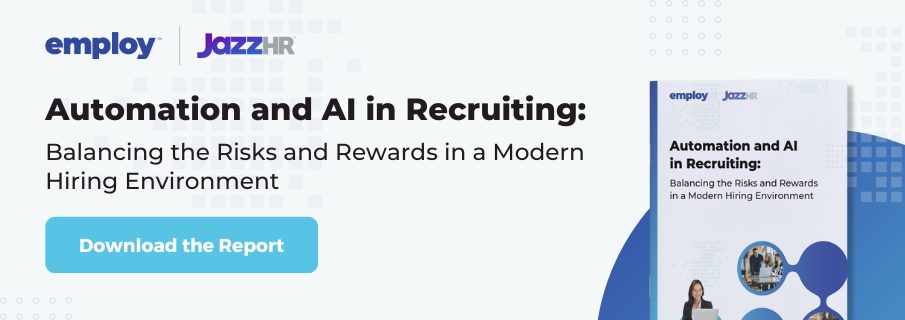Despite economic headwinds, recruiting top talent in today’s job market is still competitive and companies are hard-pressed to find quality talent. With millions of available jobs in the U.S. alone, organizations are under enormous pressure to fill open roles as quickly as possible. Resources are stretched thin, and talent teams are searching for ways to save time, increase efficiency, and streamline processes.
That’s why smart businesses incorporate automated tools into their practices every day. The recruitment automation solutions available today — like automated job posting and messaging, resume screening, interview scheduling, and more — can improve recruiting efficiency without sacrificing hiring quality or candidate experience. How? Let’s take a look.
What is Recruiting Automation?
Recruiting automation is software that streamlines the recruiting process, taking tedious tasks away from recruiters and freeing them up to do more important tasks like nurturing relationships, promoting the company’s employer brand, and developing more strategic recruiting strategies, including diversity, equity, and inclusion (DEI).
How to Apply Recruiting Automation In Your Business
There’s no question that recruiting is a human-focused job. Yet within the scope of the recruiting function, there’s a wide variety of tasks that can benefit from automation. These include the more tedious and repetitive parts of any recruiter’s job description, where automation can be applied to get the job done quickly and efficiently. For example:
#1: Job Posting
Using an automated tool, recruiters can automatically distribute job descriptions to hundreds of job boards, from top job boards like LinkedIn, Indeed, and ZipRecruiter to targeted boards for specific industries and audiences.
You can also customize posting destinations based on specific job attributes to make sure it’s seen by the most relevant candidates. And having centralized management of all your job postings means you can edit or update your job postings from one system across all locations.
#2: Resume Screening
Automation makes it easy to find the right skills and experience at scale. With automated resume screening, you can streamline the time-consuming (but necessary) process of reviewing resumes.
Automatically ingest resume or profile data into the ATS, review candidate qualifications, collect feedback from internal stakeholders, and capture decisions about whether to advance a candidate to the next stage in the process.
#3: Passive Candidate Nurturing
Passive candidates represent an incredibly valuable talent pool, but it takes effort to develop them into engaged, active applicants.
Recruitment automation lets you nurture passive candidates with automated email or text campaigns to keep them up-to-date on job openings, company news, and other relevant content. These automated communications help keep passive candidates moving toward eventual conversion with minimal effort.
#4: Candidate Communications
Automated messaging solutions can be used to streamline a variety of candidate communications: invite candidates to apply for a job, send interview confirmations, answer common questions, deliver personalized rejection letters, and so much more.
Automated messaging can be managed through your ATS, allowing recruiters to view every text thread in one place and creating an easily accessible audit trail.
#5: Interview Scheduling
Slow, inefficient interview scheduling can cause applicants to lose interest — and while you’re busy juggling schedules, they may already be meeting with your competition.
Automated scheduling tools eliminate the tedious process of checking calendars and sending invitations, allowing you to automatically propose interview times, confirm availability, and book meetings. Scheduling changes and unexpected cancellations can be communicated instantly, so neither side is left hanging.
#6: Internal Feedback and Collaboration
Sharing information within the hiring team is essential to collaborative recruiting, but it’s a resource-intensive process when recruiters have to chase down stakeholders for their input.
Automated internal communication tools allow hiring managers and other stakeholders to enter feedback on each candidate and store it in a central location, where it’s visible and accessible to the entire team — taking the guesswork out of the next steps.
Prepare Your Team: Clearing Hurdles of Automation Adoption
The benefits of recruiting automation are clear, and there are countless ways to use these technologies, but that doesn’t mean the path to adoption is easy or stress-free. By anticipating the pitfalls you may encounter along the way, you can prepare appropriately and increase your chances of success.
- #1: Fear of automation: Among the top challenges of adopting recruitment automation is people’s reaction to the concept. Automation is often depicted as a replacement for the human workforce — and no one wants to feel expendable. The truth is automation isn’t meant to replace recruiters, but instead to supplement their capabilities by taking over repetitive manual tasks. Show critics how automation can make their work easier — and advance their careers — and they’ll become fans in no time.
- #2: Internal adoption: Humans are naturally resistant to change, so successful implementation of any new technology can be a struggle. Start by ensuring that you have buy-in from the top down to create built-in support and accountability. If possible, recruit your most supportive stakeholders to help champion the initiative. Implement a thorough training program to get everyone off to a great start and celebrate your successes along the way.
- #3: Brand and experience concerns: You may face resistance from people who believe automation makes the employer brand feel robotic and sterile, leading to a poor candidate experience. You can reassure those individuals that automation can actually enhance your brand by delivering consistent messaging that’s timely, engaging, and personalized. And because automation leaves recruiters with fewer manual tasks to complete, they can focus their attention on delivering.
Go Deeper on Automation and AI in Recruiting
Adopting new tools to automate your existing hiring process can feel daunting, but as technology continues to advance, so too will the world of recruiting.
For more information on automation and how it’s transforming the world of recruiting, download the latest report from Employ: Automation and AI in Recruiting: Balancing the Risks and Rewards in a Modern Hiring Environment.





